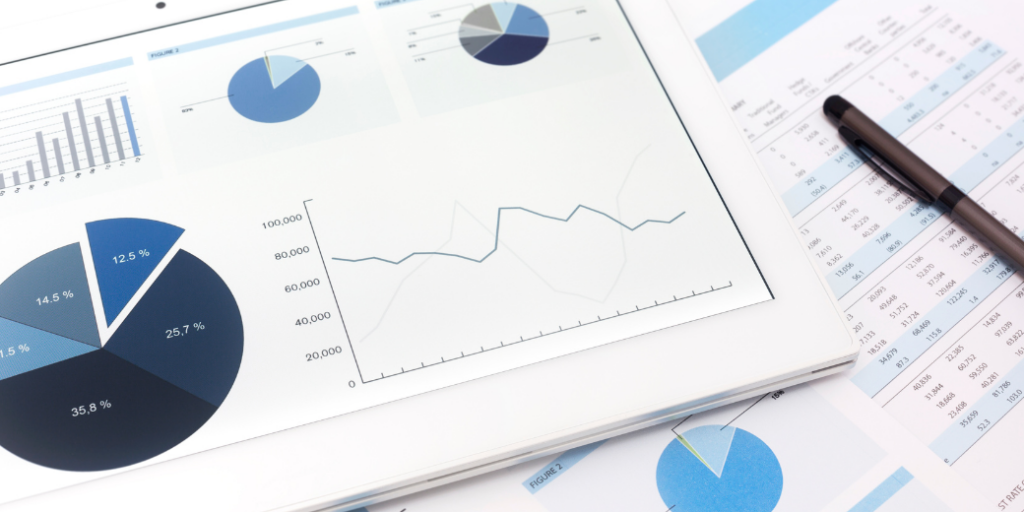Resource Center
A Guide to Market Analysis for Finance Professionals + A Case Study

Market analysis, within the context of finance professionals, refers to the systematic examination of market trends, conditions, and dynamics to make informed investment and business decisions. It involves collecting and interpreting data related to market demand and supply, economic indicators, industry trends, competitive landscapes, and company performance. This article explores the process of market analysis, complemented with a case study to provide a practical overview of its implementation in your work.
Why is Market Analysis Important for Finance Professionals
Market analysis is a critical tool for finance professionals, offering valuable insights and strategic advantages in a competitive landscape. It enables professionals to navigate market complexities, anticipate changes, and leverage data-driven insights to optimise their financial strategies and outcomes. Here’s why it’s essential:
Informed Decision Making: By analysing market trends and financial data, finance professionals can identify lucrative opportunities, strategically plan for the long term, and make informed investment decisions.
Risk Management: Market analysis helps in identifying and understanding potential risks, such as market volatility and competitive pressures, enabling the development of strategies to mitigate these risks and secure investments.
Competitive Advantage: Benchmarking competitors and understanding market dynamics assist finance professionals in improving their market positioning and identifying areas for strategic enhancement.
Performance Evaluation: Regular market analysis aids in assessing and benchmarking the performance of portfolios and companies against industry standards, facilitating timely improvements and realistic target setting.
Strategic Opportunities: Identifying emerging trends and growth areas through market analysis enables finance professionals to innovate and capitalize on new market opportunities.
Economic and Industry Insights: Comprehensive analysis of economic indicators and industry trends provides a macroeconomic understanding, influencing strategic decisions and keeping professionals competitive in evolving markets.
Industry Insights, Player Data, and Profiles to Drive Successful Market Analysis
Effective market analysis is essential for strategic planning and decision-making in any business. By understanding key components such as industry insights, player data, and company profiles, professionals can gain a comprehensive view of the market landscape. This guide explores these critical elements, providing the necessary knowledge to drive successful market analysis.
1. Industry Insights
- Understanding Market Trends Access to industry reports and trend analysis helps in identifying current and future market trends, enabling professionals to anticipate changes and adapt strategies accordingly.
- Performance Metrics: Industry insights provide benchmarks and performance metrics that aid in evaluating a company’s position within the industry.
2. Players Data
- Competitive Benchmarking: Detailed data on competitors allows for comparison of key performance indicators (KPIs), helping in identifying strengths and weaknesses relative to competitors.
- Market Share Analysis: Understanding the market share of different players helps in assessing the competitive intensity and identifying market leaders.
- Strategic Moves: Insights into the strategic initiatives of competitors, such as mergers, acquisitions, and product launches, provide valuable information for strategic planning.
3. Company Profiles
- Comprehensive Overview: Detailed company profiles offer insights into a company’s business model, financial performance, and strategic objectives.
- Shareholder Structures: Information on ownership and shareholder structures aids in understanding potential influences and conflicts of interest.
- Business Portfolios: Analysis of product lines and business segments helps in assessing the diversification and focus areas of a company.
Understanding Market Dynamics to Gauge Growth Areas and Key Indicators
Grasping market dynamics is crucial for any business aiming to stay competitive and grow sustainably. By going into the intricate details of supply and demand, market trends, and economic indicators, businesses can make informed decisions that drive success. Below outlines the essential components of market dynamics that every professional should know.
1 Supply and Demand Analysis
- Market Demand: Analysis of market demand trends helps in forecasting sales and identifying growth opportunities.
- Supply Chain Analysis: Understanding the supply chain dynamics, including key suppliers and distribution channels, aids in optimizing operations and reducing costs.
2. Economic Indicators
- Macroeconomic Factors: Monitoring economic indicators such as GDP growth, inflation rates, and employment levels helps in assessing the overall economic environment.
- Sector-Specific Indicators: Sector-specific economic indicators provide insights into the health and prospects of particular industries.
Evaluating Competitive Landscapes via SWOT and Porter’s Five Forces Frameworks
To gain a robust understanding of the competitive landscape, businesses can use SWOT and Porter’s Five Forces frameworks. These tools provide a structured approach to evaluating internal and external factors that influence market positioning.
1 SWOT Analysis
- Strengths and Weaknesses: Identifying the internal strengths and weaknesses of competitors helps in developing competitive strategies.
- Opportunities and Threats: Understanding external opportunities and threats allows for proactive risk management and strategic positioning.
2. Porter’s Five Forces
- Competitive Rivalry: Analysis of the intensity of competitive rivalry within the industry.
- Bargaining Power of Suppliers and Buyers: Evaluating the bargaining power of suppliers and buyers helps in understanding the dynamics of pricing and cost structures.
- Threat of New Entrants and Substitutes: Assessing the threat of new entrants and substitutes helps in identifying potential disruptions and planning for contingencies.
Manage Risks to Understand Where the Vulnerabilities Are
Understanding and managing risks is crucial to ensuring long-term success. By identifying potential vulnerabilities, businesses can develop strategies to mitigate these risks and safeguard their operations. This section will explore the various types of risks that companies face and outline effective mitigation strategies.
1 Identifying Risks
- Market Risks: Analysis of market volatility and economic downturns helps in identifying potential market risks.
- Operational Risks: Understanding the operational risks, including supply chain disruptions and technological failures.
- Financial Risks: Monitoring financial risks such as credit risks, liquidity risks, and currency fluctuations.
2. Mitigation Strategies
- Diversification: Implementing diversification strategies to spread risk across different markets and products.
- Hedging: Using financial instruments to hedge against market and financial risks.
- Compliance and Governance: Ensuring adherence to regulatory requirements and implementing robust governance practices to mitigate compliance risks.
Case Study: Conducting Market Analysis for a Finance Firm in the Consumer Electronics Industry
This case study demonstrates how a finance professional conducts market analysis for their client in the consumer electronics sector. The analysis includes industry insights, players’ data, company profiles, market dynamics, competitive landscapes, and risk management. By combining desktop research with insights from a comprehensive data platform, the finance professional provides actionable advice to client.
Step 1: Conduct Research to Discover Industry Insights, Key Metrics, and Upcoming Regulations
We begin the first step by analysing overall industry trends to identify potential opportunities in the market. This is followed by comparing multiple relevant companies across various metrics to assess their performance. Finally, we review any key regulations that may be influencing the industry.
Understanding Market Trends:
To begin, the finance professional utilises desktop research and data platforms to identify emerging trends such as the growing interest in smart home devices and wearable technology. This indicates a shift in consumer preferences, and the professional advises the client to explore investment opportunities in these areas by developing portfolios with companies operating in this space, aiming for high returns.
Benchmark Performance Metrics:
The next step is to compare benchmarks like profit margins, revenue growth rates, and market penetration. This comparison reveals which companies in the client’s portfolio are underperforming relative to industry standards. The finance professional then collaborates with the client to review these companies’ cost structures and pricing strategies.
Check Key Regulations and Upcoming Changes:
Finally, it is crucial to stay informed about upcoming regulatory changes in the consumer electronics industry, such as new environmental compliance standards. The finance professional advises the client to adjust their strategies accordingly to ensure compliance, thereby avoiding potential penalties and maintaining a positive investment outlook.
Step 2: Dive Deeper into the Competitors to Gauge Competitive Landscape
Understanding the competitive landscape is vital for positioning the client effectively within the market. This step involves analysing where competitors are focusing their efforts, assessing market share, and evaluating strategic moves.
Identifying Competitors’ Focus Areas:
The finance professional analyses the competitive landscape, noting that leading companies are heavily investing in research and development (R&D), particularly in artificial intelligence (AI) and Internet of Things (IoT) technologies. They recommend that the client’s portfolio companies allocate more budget to R&D to maintain a competitive edge.
Conduct Market Share Analysis:
A thorough market share analysis reveals that a few companies dominate the smart home segment. The finance professional investigates the reasons behind these companies’ leadership positions and suggests that the client adopt similar strategies, such as focusing on innovative product features and implementing aggressive marketing campaigns.
Evaluating Strategic Moves:
Insights into competitors’ recent strategic initiatives, including the launch of smart speakers and home automation systems, are crucial. The finance professional advises the client to consider investing in or acquiring companies developing similar technologies, ensuring that these investments offer unique features to stand out in the market.
Step 3: Understand Industry Operators and Structures to Gauge Common Practice and Trends
Understanding the operational frameworks and structures within the industry is essential for benchmarking and identifying best practices. This step involves a detailed examination of industry operators and their business models.
Understand the Profiles of the Major and Emerging Players:
Detailed profiles of leading consumer electronics companies offer valuable insights into their business models and strategic objectives. The finance professional recommends that the client adopt the best practices observed in successful competitors, such as optimising supply chain management and forming strategic partnerships.
Examining Shareholder Structures:
An analysis of shareholder structures reveals significant investments from tech-focused venture capital firms in key competitors. The finance professional advises the client to pursue similar investment opportunities to strengthen their financial position and support strategic initiatives.
Evaluating Business Portfolios:
Upon examining the business segments of competitors, they note a strong focus on emerging technologies like augmented reality. They assess the feasibility of the client expanding into this market, potentially through partnerships or acquisitions to quickly establish a foothold.
Step 4: Identify Growth Opportunities and Drivers
Identifying growth opportunities and understanding the factors that drive them is crucial for strategic planning. This step involves analysing supply and demand dynamics, as well as economic indicators that could influence the market.
Conduct Supply and Demand Analysis:
The finance professional examines market demand forecasts, which indicate a projected increase in consumer spending on smart home devices. They advise the client to scale up production capacity or invest in companies poised to meet this anticipated demand.
Conduct Supply Chain Analysis:
Insights into key suppliers and distribution channels for smart home products prompt the finance professional to recommend that the client optimise their supply chains by partnering with reliable suppliers and expanding their distribution networks.
Reviewing Economic Indicators:
Monitoring macroeconomic factors such as GDP growth and inflation rates is essential for assessing the broader economic environment. The finance professional adjusts the client’s investment strategies in response to these indicators, ensuring competitiveness without compromising profitability.
Step 5: Evaluate and Understand Where the Strengths and Weaknesses within the Business
A thorough evaluation of the client’s strengths and weaknesses, using frameworks like SWOT analysis and Porter’s Five Forces, is essential for systematically understanding the internal and external factors that influence the business.
SWOT Analysis:
The finance professional conducts a SWOT analysis, identifying strong R&D capabilities but weak brand recognition among the client’s portfolio companies. They recommend launching a marketing campaign to enhance brand visibility and leverage R&D strengths.
Porter’s Five Forces:
The competitive analysis reveals intense rivalry among smart home product manufacturers. The finance professional advises the client to differentiate their products with unique features and superior customer service. They also suggest negotiating long-term contracts with suppliers to manage high supplier power and focusing on brand building to counter the threat of new entrants.
Step 6: Recognise and Manage Risks from Both External and Internal Environments
The final step involves identifying potential risks and developing strategies to mitigate them, ensuring long-term stability and success.
Identifying Risks:
The finance professional conducts a risk analysis, considering factors such as market volatility and potential economic downturns. They recommend diversifying product portfolios to spread risk and develop contingency plans to address supply chain disruptions.
Implementing Mitigation Strategies:
To safeguard against potential risks, the finance professional advises the client to enter new markets and product categories, such as launching wearable technology to complement smart home products. They also recommend implementing hedging strategies to protect against adverse currency movements and adopting sustainable practices to ensure compliance with new environmental regulations.
By systematically conducting market analysis, the finance professional equips the client with the insights needed to make informed strategic decisions, effectively manage risks, and capitalise on emerging opportunities within the consumer electronics market.
How a Data Platform Can Save Days of Market Analysis for Finance Professionals
In today’s fast-paced financial landscape, efficiency and accuracy are paramount. A robust data platform can transform how finance professionals conduct market analysis, providing instant access to critical information and saving valuable time.
- Informed Decision Making: A data platform can give instant access to millions of public and private company profiles and industry reports to quickly identify lucrative opportunities.
- Risk Management: Real-time monitoring of market volatility, economic indicators, and advanced search filters for M&A deals and fundraising activities to proactively identify and mitigate risks.
- Competitive Advantage: Utilise detailed competitive benchmarking with key performance indicators, market share analysis, and insights into competitors’ strategic moves for strategic enhancement.
- Performance Evaluation: Leverage automated performance metrics, benchmarks, and peer comparison features for accurate and timely assessments.
- Strategic Opportunities: Get updates on emerging trends and growth areas, along with proprietary industry reports and on-demand consulting services to support innovation and strategic investments.
- Economic and Industry Insights: Benefit from comprehensive coverage of macroeconomic factors, sector-specific indicators, insights from media outlets, and expert interviews for strategic decisions.
Maximizing Financial Strategies through Effective Market Analysis
Market analysis is not just a routine task but a strategic imperative for finance professionals. It equips them with the insights needed to navigate complexities, mitigate risks, and seize opportunities in a competitive market. The key takeaway from this guide is the undeniable value of leveraging detailed market analysis and advanced data platforms to make informed, strategic decisions. By doing so, finance professionals can enhance their investment outcomes, stay ahead of competitors, and drive long-term growth for their clients.
Experience the benefits of an all-in-one data platform SPEEDA with a free consultation or sign up for a 7-day free trial. Contact us today to streamline your market research and drive better decisions.



























